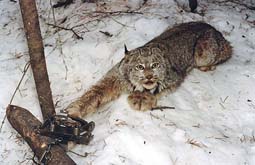Because lynx are nocturnal and very shy, they are not shot but trapped. Traps are often positioned where the lynx preferably dwell, i.e. where they need to cross streams or on wild paths. Often, the traps are prepared with special scents, e.g. urine or other secretions. If an animal triggers a trap, it is caught painfully. Often, the trap snatches the most sensitive body parts of the animal such as its snout or eye area. Confused, scared and in pain, the animals attempt to free themselves, often dislocating joints and injuring themselves seriously. In order to free themselves, they sometimes bite off their own limbs. Even if an animal is able to free itself from the trap, it has practically no chance of surviving. It will die of infections, starve to death or become easy prey for other predators. Animals unable to free themselves die a slow death or are found by the trapper and are beaten to death or killed by other animals.
An additional problem is that other animals are sometimes also trapped, e.g. other protected animals or domestic animals, such as dogs and cats.
Trapping for fur must be rejected from an animal protection perspective. This has nothing to do with securing or controlling populations in the sense of intelligent wildlife management – although this is often claimed by the fur industry.

